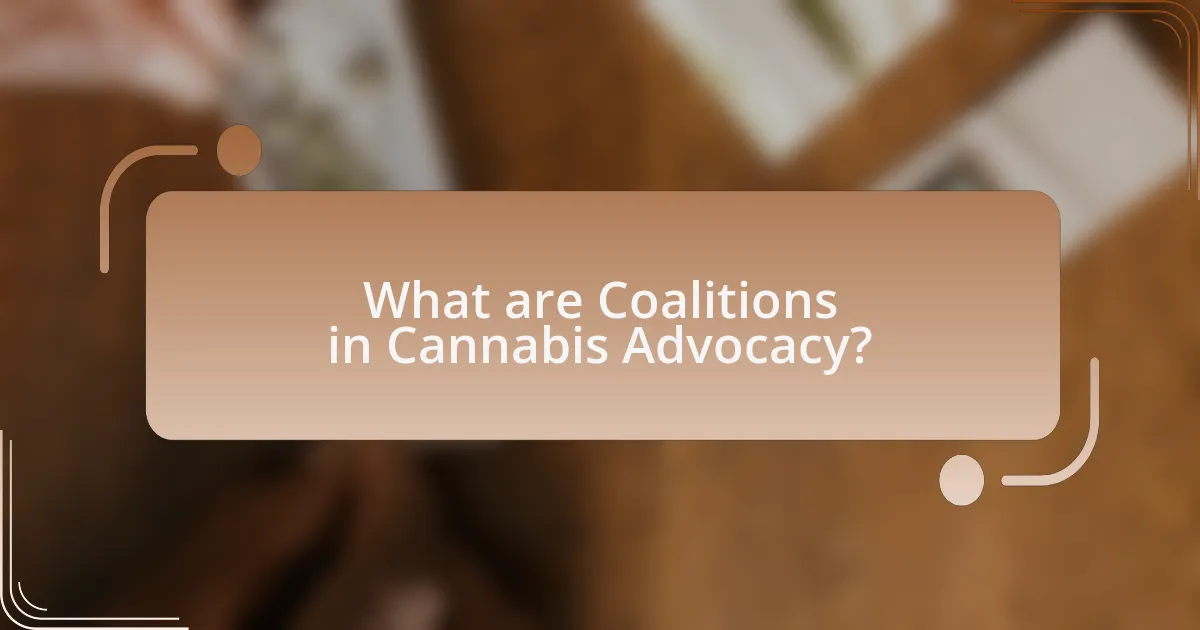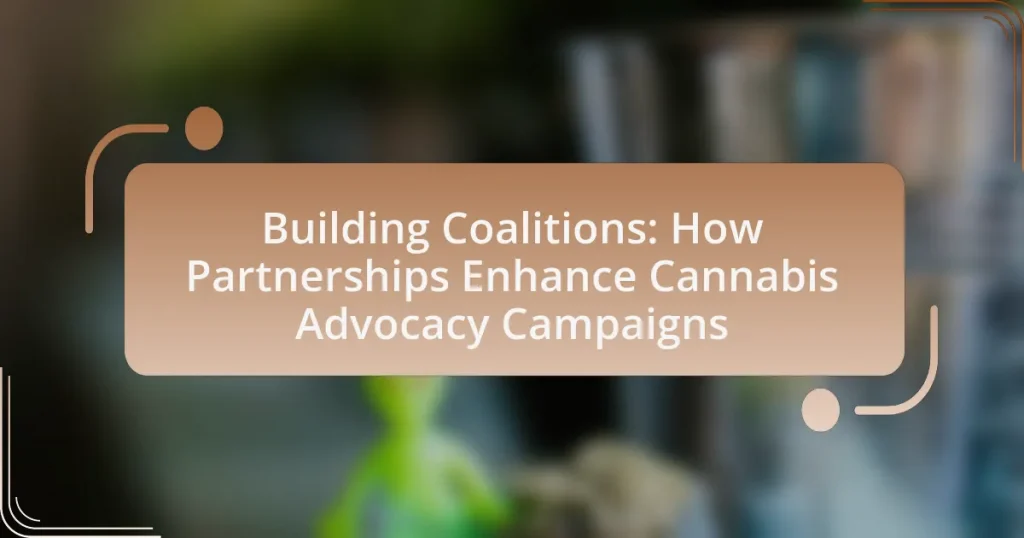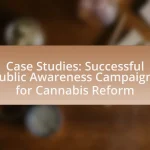The article focuses on the role of coalitions in cannabis advocacy, highlighting how collaborative groups formed by various stakeholders, including organizations, activists, and community members, work together to promote policy changes related to cannabis legalization and regulation. It discusses the formation of these coalitions, the key stakeholders involved, and the advantages they provide over individual advocacy efforts, such as increased visibility and resource sharing. Additionally, the article explores effective partnerships that enhance advocacy campaigns, best practices for coalition building, and strategies to overcome common challenges faced by cannabis advocacy coalitions. Overall, it emphasizes the importance of collaboration in achieving successful cannabis reform initiatives.

What are Coalitions in Cannabis Advocacy?
Coalitions in cannabis advocacy are collaborative groups formed by various stakeholders, including organizations, activists, and community members, to promote and support cannabis-related policy changes. These coalitions leverage collective resources, expertise, and networks to amplify their influence and effectiveness in advocating for legalization, regulation, and social justice related to cannabis. For instance, the National Cannabis Industry Association (NCIA) serves as a coalition that unites businesses and advocates to shape federal cannabis policy, demonstrating the power of collaboration in achieving common goals.
How do coalitions form in the context of cannabis advocacy?
Coalitions in cannabis advocacy form through the collaboration of diverse stakeholders, including advocacy groups, medical professionals, and community organizations, united by shared goals such as legalization or reform. These coalitions often emerge from the recognition of common interests and the need for a unified voice to influence policy and public perception. For instance, the formation of the National Organization for the Reform of Marijuana Laws (NORML) in 1970 brought together various groups advocating for cannabis law reform, demonstrating how shared objectives can lead to effective coalitions. Additionally, successful coalitions leverage resources, expertise, and networks to amplify their impact, as seen in the coalition efforts during the legalization campaigns in states like Colorado and California, where multiple organizations worked together to achieve legislative success.
What key stakeholders are involved in cannabis advocacy coalitions?
Key stakeholders involved in cannabis advocacy coalitions include non-profit organizations, industry representatives, medical professionals, policymakers, and community activists. Non-profit organizations often lead advocacy efforts by mobilizing public support and providing resources. Industry representatives contribute insights on market dynamics and regulatory challenges. Medical professionals advocate for patient access and research on cannabis benefits. Policymakers play a crucial role in shaping legislation and regulations. Community activists raise awareness and drive grassroots movements, ensuring diverse voices are heard in the advocacy process. These stakeholders collectively enhance the effectiveness of cannabis advocacy campaigns by leveraging their unique perspectives and expertise.
How do shared goals influence coalition formation?
Shared goals significantly influence coalition formation by aligning the interests and motivations of diverse stakeholders. When organizations or individuals pursue common objectives, they are more likely to collaborate, pooling resources and expertise to achieve these goals. For instance, in cannabis advocacy, groups advocating for legalization may unite to amplify their voices and increase their impact, as seen in the successful coalition efforts in states like California, where various advocacy groups collaborated to pass Proposition 64 in 2016. This alignment not only fosters trust and cooperation among coalition members but also enhances the overall effectiveness of their advocacy efforts, demonstrating that shared goals are a critical factor in successful coalition formation.
Why are coalitions important for cannabis advocacy?
Coalitions are important for cannabis advocacy because they unify diverse stakeholders to amplify their collective voice and influence policy change. By bringing together various organizations, activists, and community members, coalitions can pool resources, share expertise, and create a more comprehensive approach to advocacy. For instance, the National Organization for the Reform of Marijuana Laws (NORML) has successfully collaborated with other groups to push for legislative reforms, demonstrating that a united front can lead to significant advancements in cannabis legalization efforts.
What advantages do coalitions provide over individual advocacy efforts?
Coalitions provide greater collective power and resource sharing compared to individual advocacy efforts. By uniting diverse stakeholders, coalitions amplify their voice, increase visibility, and enhance credibility, which can lead to more significant influence on policy decisions. For instance, coalitions can pool financial resources, expertise, and networks, enabling them to launch more comprehensive and effective campaigns than individuals could achieve alone. Research shows that collaborative efforts in advocacy often result in higher success rates, as seen in various public health initiatives where coalitions have successfully influenced legislation through combined efforts.
How do coalitions enhance the visibility of cannabis issues?
Coalitions enhance the visibility of cannabis issues by uniting diverse stakeholders to amplify advocacy efforts. This collective approach increases public awareness and media coverage, as coalitions can leverage the combined resources and networks of their members. For instance, coalitions often organize joint campaigns, events, and educational initiatives that attract greater attention than individual efforts. Research indicates that collaborative advocacy can lead to a 30% increase in public engagement on cannabis-related topics, demonstrating the effectiveness of coalitions in raising visibility.

How do Partnerships Strengthen Cannabis Advocacy Campaigns?
Partnerships strengthen cannabis advocacy campaigns by leveraging diverse resources, expertise, and networks to amplify messaging and reach broader audiences. Collaborative efforts among organizations, businesses, and community groups enhance credibility and foster a unified front, which is essential for influencing public policy and shifting societal perceptions. For instance, coalitions that include medical professionals, legal experts, and patient advocates can present a well-rounded argument for cannabis legalization, supported by scientific research and personal testimonies. This multifaceted approach not only increases the visibility of advocacy efforts but also attracts media attention and public support, ultimately leading to more effective campaigns.
What types of partnerships are most effective in cannabis advocacy?
Collaborative partnerships between advocacy organizations, medical professionals, and community groups are most effective in cannabis advocacy. These partnerships leverage diverse expertise and resources, enhancing outreach and credibility. For instance, organizations like the Drug Policy Alliance often collaborate with health professionals to provide evidence-based information, which strengthens their advocacy efforts. Additionally, partnerships with local community groups can mobilize grassroots support, as seen in successful campaigns for legalization in states like California and Colorado, where community engagement played a crucial role in shaping public opinion and policy.
How do partnerships with non-profit organizations impact advocacy efforts?
Partnerships with non-profit organizations significantly enhance advocacy efforts by leveraging shared resources, expertise, and networks to amplify messages and reach broader audiences. For instance, non-profits often possess established credibility and community trust, which can lend legitimacy to advocacy campaigns, particularly in sensitive areas like cannabis reform. Research indicates that coalitions involving non-profits can increase the effectiveness of advocacy by 30% through coordinated outreach and mobilization strategies, as demonstrated in studies conducted by the National Council of Nonprofits. These collaborations enable the pooling of financial resources, access to specialized knowledge, and the ability to engage diverse stakeholders, ultimately leading to more impactful advocacy outcomes.
What role do businesses play in cannabis advocacy partnerships?
Businesses play a crucial role in cannabis advocacy partnerships by providing financial support, resources, and expertise to advance legislative and social change. Their involvement often includes funding advocacy campaigns, which can significantly amplify the reach and impact of initiatives aimed at reforming cannabis laws. For instance, in 2020, the cannabis industry contributed over $2 million to advocacy groups pushing for legalization in various states, demonstrating the financial commitment businesses have towards these efforts. Additionally, businesses leverage their networks and influence to engage stakeholders, policymakers, and the public, thereby fostering broader coalitions that enhance the effectiveness of advocacy campaigns.
How can coalitions leverage partnerships for greater impact?
Coalitions can leverage partnerships for greater impact by combining resources, expertise, and networks to amplify their advocacy efforts. By collaborating with diverse stakeholders, such as community organizations, businesses, and policymakers, coalitions can enhance their reach and effectiveness in promoting cannabis-related initiatives. For instance, partnerships can facilitate access to funding, provide valuable insights into regulatory landscapes, and foster community engagement, which are critical for successful advocacy campaigns. Research indicates that coalitions that engage in strategic partnerships often achieve higher levels of influence and policy change, as evidenced by the increased legalization efforts in states where multi-stakeholder coalitions have been active.
What strategies can coalitions use to build effective partnerships?
Coalitions can build effective partnerships by establishing clear communication channels and shared goals among members. Effective partnerships rely on open dialogue, which fosters trust and collaboration, enabling coalition members to align their objectives. Research indicates that coalitions with defined roles and responsibilities experience higher levels of engagement and productivity, as seen in the study “Coalition Effectiveness: A Review of the Literature” by Butterfoss and Kegler, which highlights the importance of structured communication in achieving coalition success. Additionally, regular meetings and collaborative decision-making processes enhance relationship-building and ensure that all voices are heard, further solidifying the partnership.
How do partnerships facilitate resource sharing among coalition members?
Partnerships facilitate resource sharing among coalition members by creating a collaborative framework that allows for the pooling of financial, human, and informational resources. This collaboration enables coalition members to leverage each other’s strengths, such as expertise in advocacy, access to funding, and networks for outreach. For instance, a study by the National Council of Nonprofits highlights that coalitions can increase their impact by sharing resources like training programs and marketing materials, which enhances overall effectiveness in advocacy efforts. By working together, coalition members can achieve greater reach and efficiency than they could individually, thus maximizing their collective resources for cannabis advocacy campaigns.

What Best Practices Exist for Building Effective Coalitions?
Effective coalitions are built through clear communication, shared goals, and mutual respect among members. Establishing a common vision ensures that all participants are aligned and motivated towards a unified objective. Research indicates that coalitions with defined roles and responsibilities enhance accountability and effectiveness, as seen in the “Coalition Effectiveness Framework” by the Centers for Disease Control and Prevention, which emphasizes the importance of structured collaboration. Additionally, regular evaluation and feedback mechanisms strengthen relationships and improve coalition performance, as demonstrated in various successful advocacy campaigns.
How can coalitions ensure effective communication among partners?
Coalitions can ensure effective communication among partners by establishing clear communication protocols and regular check-ins. These protocols should define the channels of communication, frequency of updates, and methods for sharing information, which fosters transparency and accountability. Research indicates that coalitions with structured communication strategies experience higher levels of collaboration and trust among partners, leading to more successful outcomes in advocacy efforts. For instance, a study published in the Journal of Community Psychology found that effective communication practices significantly enhance coalition effectiveness, demonstrating the importance of these strategies in achieving shared goals.
What tools and platforms are best for coalition communication?
The best tools and platforms for coalition communication include Slack, Microsoft Teams, and Zoom. These platforms facilitate real-time messaging, video conferencing, and file sharing, which are essential for effective collaboration among coalition members. For instance, Slack allows for organized channels that can be dedicated to specific topics or projects, enhancing focused discussions. Microsoft Teams integrates seamlessly with other Microsoft Office applications, making document collaboration straightforward. Zoom provides reliable video conferencing capabilities, which are crucial for virtual meetings, especially in advocacy campaigns where face-to-face interaction may be limited. These tools have been widely adopted in various sectors, including advocacy, due to their ability to streamline communication and improve coordination among diverse groups.
How can coalitions address conflicts among partners?
Coalitions can address conflicts among partners by establishing clear communication channels and conflict resolution mechanisms. Effective communication allows partners to express their concerns and perspectives openly, which can lead to mutual understanding and collaborative problem-solving. For instance, regular meetings and feedback sessions can help identify issues early and facilitate dialogue. Additionally, implementing structured conflict resolution processes, such as mediation or negotiation, can provide a framework for resolving disputes amicably. Research indicates that coalitions with defined roles and responsibilities experience fewer conflicts, as clarity reduces misunderstandings and promotes accountability.
What are the common challenges faced by cannabis advocacy coalitions?
Cannabis advocacy coalitions commonly face challenges such as legal restrictions, funding limitations, and public perception issues. Legal restrictions arise from varying state and federal laws regarding cannabis, which can hinder coalition activities and advocacy efforts. Funding limitations often stem from the stigma associated with cannabis, making it difficult for coalitions to secure financial support from traditional sources. Additionally, public perception issues can create barriers to gaining widespread support, as misconceptions about cannabis use and its effects persist in society. These challenges collectively impact the effectiveness and reach of cannabis advocacy coalitions.
How can coalitions overcome funding challenges?
Coalitions can overcome funding challenges by diversifying their funding sources and establishing strong partnerships with various stakeholders. By seeking financial support from multiple avenues such as grants, donations, and sponsorships, coalitions can reduce reliance on a single funding source, thereby increasing financial stability. For instance, coalitions focused on cannabis advocacy can collaborate with non-profit organizations, businesses, and government entities to secure funding that aligns with their mission. Research indicates that coalitions that engage in collaborative fundraising efforts often achieve greater financial success, as they can pool resources and share costs, enhancing their overall capacity to sustain initiatives.
What strategies can be employed to maintain coalition member engagement?
To maintain coalition member engagement, regular communication and inclusive decision-making are essential strategies. Regular communication ensures that all members are informed about coalition activities, progress, and challenges, fostering a sense of belonging and accountability. For instance, utilizing newsletters, meetings, and digital platforms can keep members updated and involved. Inclusive decision-making allows members to contribute their perspectives and expertise, which enhances their investment in the coalition’s goals. Research indicates that coalitions with high member engagement report greater success in achieving their objectives, as seen in the study “Coalition Effectiveness: A Review of the Literature” by Butterfoss and Kegler, which highlights the importance of member involvement in coalition activities for sustained engagement.
What practical tips can enhance coalition-building efforts in cannabis advocacy?
To enhance coalition-building efforts in cannabis advocacy, organizations should prioritize clear communication and shared goals among stakeholders. Establishing a common vision fosters unity and ensures that all parties are aligned in their objectives, which is crucial for effective collaboration. Additionally, leveraging diverse networks can expand reach and influence; for instance, engaging with health professionals, legal experts, and community leaders can provide valuable insights and resources. Research indicates that coalitions with varied expertise are more successful in achieving policy changes, as they can address multiple facets of cannabis advocacy, from public health to legal reform. Regular meetings and updates also strengthen relationships and maintain momentum, ensuring that all members remain engaged and informed about progress and challenges.


